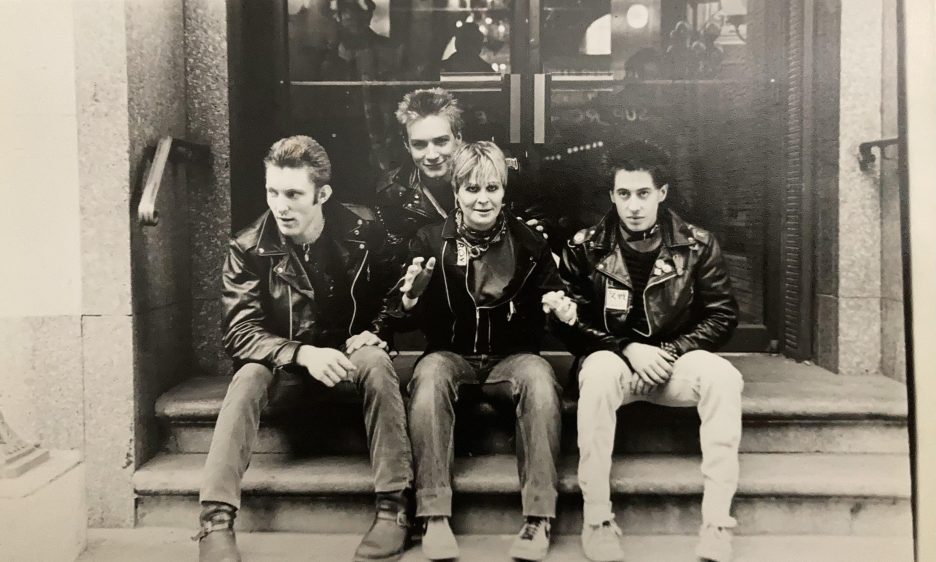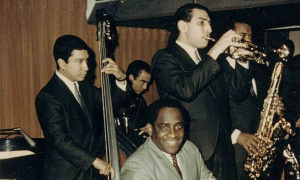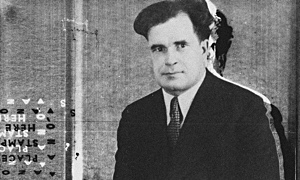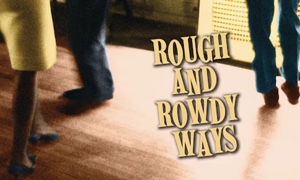Home » Jazz Articles » Hardly Strictly Jazz » Philadelphia, Mon Amour
Philadelphia, Mon Amour

Courtesy ercoli
I saw the best minds of my generation … continue to be the people who foster the change we want to see.
—Skip Heller
Our finest jazz documentarian, Robert Mugge, whose films about Sun Ra, Gil Scott-Heron, and Sonny Rollins are gold standard stuff, captured that era in all its vainglory and shame. Amatuer Night At City Hall: The Story of Frank L.Rizzo—which was shot in 1977 and released the following year— captures the time in a skilled, knowing, and unvarnished way.
Watching Amatuer Night hits very close to home, revisiting the proud stupidity and overt racism of South Philly circa 1977. This is where I had after school jobs, and for me to see it is to revisit people like my old bosses and even some of my relatives. There's footage of the old man Italian band I used to sometimes play with at the Triangle Tavern, subbing for the guitarist, complete with chainsmoking Italians complaining about "the coloreds" and praising Rizzo as a great man, drinking Schaefer beer, and being generally frightening. I cannot recommend this film enough.
The city that came up in the wake of that horror was equal parts old struggle and new ideas. For the young, there was punk rock. As indispensable as Amatuer Night is, so is Nancy Barile's memoir of the early eighties Philly punk scene, I'm Not Holding Your Coat (Bazillion Points). She was not the only figure shaping that scene. A complete account of time and place would burrow into the formidable efforts of club-bookers Bobby Startup and David Carroll, disc jockey Lee Paris, and record store guys Bob Dickie and Jacy Webster, among others. There were two differences between her and them. First, they each had a brick and mortar venue from which to work, and secondly, they're not women.
(There was much more to underground Philadelphia of that era than just hardcore punk, but that will have to wait for another book.)
 The punk rock memoir is too often a self-aggrandizing affair that gives the author the chance to overstate his own importance. Not always: Black Flag / Circle Jerks frontman Keith Morris wrote a hilarious (and unsparingly self-critical) one called My Damage (Hachette Books) that is not for the timid. Then there is Get In The Van: On The Road With Black Flag, by Henry Rollins (2.13.61), which might be the magnum opus of the genre. Rollins' recollections— not only of his own live shows but seemingly everybody else's—are communicated in a language that brings the music and the times to life.
The punk rock memoir is too often a self-aggrandizing affair that gives the author the chance to overstate his own importance. Not always: Black Flag / Circle Jerks frontman Keith Morris wrote a hilarious (and unsparingly self-critical) one called My Damage (Hachette Books) that is not for the timid. Then there is Get In The Van: On The Road With Black Flag, by Henry Rollins (2.13.61), which might be the magnum opus of the genre. Rollins' recollections— not only of his own live shows but seemingly everybody else's—are communicated in a language that brings the music and the times to life. Coat would be unique just because relatively few punk rock women of that period have written memoirs. But it also stands out because Philadelphia's scene was so unique. For one thing, we had more art schools than just about any other major American city, so that brought with it a bigger focus on visual art, fashion, and design, which meant a much more tangible LGBTQ influence on the music and the club scene. There was more racial integration as well. The first punk rock band to establish themselves in town was Pure Hell, all African-American, and they were venerated. Importantly, women were pushing their way to the front—not just at the shows, but behind the scenes, doing radio, fanzines, and playing in bands. Barile, then still Nancy Petriello, was managing the Sadistic Exploits, local contenders for international punk rock stardom.
The Exploits were always formidable. Fronted by Bryan Lathrop, who looked something like a cross between Billy Idol and current PA Lt. Governor John Fetterman, and was a skateboarder who ran away from the nearby suburb of Havertown. He was simultaneously funny and intense, with a raw, athletic way of stalking a stage. Also, the 'Sploits were always very well-rehearsed, with quality equipment and bandstand professionalism. In addition, xeroxed flyers for their gigs were pasted up on seemingly every phone pole and flat outdoor surface in the 215 area code.
Everything about that enterprise was very hard work. Barile goes into the filthy, tedious, backbreaking task that was wheatpasting (hanging paper flyers with a primitive homemade adhesive of water and flour). After a couple of hours, you'd be dirty enough from paste and black xerox toner that no restaurant would let you walk in and sit down. Your clothes forever bore the damage of wallpapering the city one 8 ½" by 11" flyer at a time. The task was enormous, and they met it unfailingly.
At the same time, Nancy had a grown up job at a law office (working at an early desktop computer called a Wang, and oh the fun we had with that) and an apartment in a decent building (instead of a cheap room in one of those houses in West Philly where there were always lots of parties). She functioned admirably in the professional world, but would famously return to the office after hours and secretly run off band flyers on the company copy machine. In application, punk was very often a world of X-acto knives, glue stick, rub-on press type, stencils, and cut up magazines —a labor-intensive lifestyle.
October 3, 1981 (the night before my 16th birthday), Nancy mounted the first Punk Fest, at the 16th and Fitzwater Octavius V. Catto Elks Center, the very same Elks Center where Bessie Smith's viewing had been held forty-four years earlier. Punk Fest featured a host of local bands, with the Exploits headlining. The Elks Center was packed with seemingly everyone I knew, all ages, wall to wall, and joyous. Me and my friend Eddie Engel leaned against the wall and rang in my birthday. 16th and Fitz was an African-American neighborhood that would not succumb to gentrification for another dozen years. The locals didn't seem to mind our being there that night, the punks treated the venue with respect, and catastrophe was kept to a minimum. I'm pretty sure the sound system was rented from Cinasound, a local company who provided stage PA's for "battle of the bands" type events and who had little to no experience with punk rock. The sound was muddy in that big boomy room, but the audience truly united around this DIY miracle, and the bands were all great that night, to a one, especially the 'Sploits. It was a high water mark for Philadelphia music. (Also on the bill that night was Informed Sources, led by guitarist Frank Blank, who would later change his last name back to Moriarty and become the premiere Jimi Hendrix biographer/historian.)
Nancy's recounting of the work that went into Punk Fest is essential reading for anyone who wants to create big events, and she tells it beautifully, avoiding self-congratulatory DIY hegemony, choosing instead to outline the work and acknowledging the team effort. Them flyers didn't wheatpaste themselves.
Much of this book is about a young woman who chooses a series of roles for herself and then quickly grows into them. Again, the women on the scene in Philadelphia were forces in shaping and documenting the era. It was particularly heartening to see some space in Coat devoted to the truly original Beth Lejman, who played combo organ in the funk/art/punk/Beefheartian Stickmen, the most compelling local group of the period. Not that there weren't other interesting bands giving the fellas a run for their money. The mostly-female Head Cheese, who mixed dada and girl pop, were also making interesting music, and would soon smooth out their sound, change their name to Book of Love, and enjoy a 1985 hit with "Boy." They too get a deserved nod here.
(Palmyra Delran, now a bona fide cult figure active in New York, was also a very active multi-instrumentalist on the scene at the time, playing in the Sic Kidz, Mother May I, the Friggs, and Pink Slip Daddy, among others.)
1981 might have been the glory point of musical convergence. Punk rock was stylistically at its widest angle. The old-school barre chord style typified by the Ramones was still viable, while hardcore was starting to stake its claim. Some bands —notably X and the Dead Kennedys— could straddle the stylistic lines, and the records they made remain compelling. Hardcore, with its ties to skateboards and surf, had a younger audience built in, and all ages shows became the standard as this style became the lingua franca of American punk, due in no small part to the huge national influence of Black Flag as well as the DC bands, most notably Minor Threat. The disadvantages to this were twofold. First, the gigs became more violent. Nancy writes about getting battered at shows to the point where her coworkers offered to help her, fearing she had been the victim of domestic violence. Secondly, the music itself had largely morphed from a big eclectic tent to the codified thrash style—the "punk polka."
Nancy loved hardcore. Its arrival signalled a changing of the musical guard. The increased violence made it risky to go hear music, and the police quickly enough set out on a mission against punk. As Coat moves along, the intensification of punk rock's physical toll is revealed, with casually remembered tales of broken bones and emergency room visits. The shows' largely deserved reputation for audience brutality made it difficult to secure decent venues, so shows were often booked in obscure spaces in scary neighborhoods, which meant a perilous journey to and from the gig (where locals laid in wait to battle the punks), not to mention the mayhem once you were in the hall. The increased presence of law enforcement was oppressive and unmistakable. Nancy's recollection of the raid on the August '82 Kater St show (a daytime punk block party) paints a clear picture of what had become the usual (and occasionally costly) hassle. In addition, the music— to my ears— was no longer as exciting. The monochromatic "loudfasthard" didn't often fire my imagination. I remember barely escaping the police on Kater St that day and feeling burnt out. It didn't take long for a Mose Allison record to find me, and... here I am.
Roughly a year later, Nancy left for Boston, having met and fallen in love with SS Decontrol's guitarist and songwriter Al Barile. They got married and still are. She left town not only having set a high bar for how to present independent music, but also having helped establish the ways, means, and networks that still make all ages punk shows happen. I honestly can't imagine who else in town would have been able to do what she did. A million years before Gilman Street spawned its celebrated Bay Area variant of diverse punk, the City of Brotherly Love was a place where sisters were doing it for themselves— playing in bands, putting on gigs, getting records released, and putting out fanzines.
Once ensconced in Boston, Nancy Barile became part of punk rock life there. Eventually, she became a teacher, was awarded the 2013 Kennedy Center/Stephen Sondheim Inspirational Teacher Award and the Boston Red Sox Most Valuable Educator, among other citations.
Bryan Lathrop didn't do much musically after the 'Sploits disbanded. He instead studied poetry, then went off to Central America to help poor people. He became a brilliant photographer and designer with an amazing wife and two really fantastic children. Many people died, including Beth Lejman and Pete Baker of the Stickmen, Mark Laurick, Lee Paris, and Steve Fritz, who helmed the great local fanzine Terminal. Frank from the Informed Sources has written great books about auto racing and rock music. I saw the best minds of my generation... continue to be the people who foster the change we want to see. Philadelphia did finally spawn a truly major punk rock band, the Dead Milkmen, whose "Punk Rock Girl" is canonical. And one probably major one, Ruin, whose records have aged very well.
Bill Evans once famously observed that jazz might be less a "what" than a "how," and it's easy to say the same of punk as a DIY "how" of being creative and making your own uncompromising path. Charles Ives, Harry Partch, and Sun Ra are among the spiritual forefathers. In these last 45 years (the first Ramones album was released in 1976), that "how" has gone through a myriad of twists, turns, and developments. Between its diversity of musical style and its self-starter ethic, punk remains a "how," one whose lasting effects include that women took the reins of the culture in so many ways, none more than Nancy. I'm Not Holding Your Coat is likely as good as it will ever get for those who want to know about hardcore in Philadelphia. I oughta know.
< Previous
Take Five with Marcio Resende
Comments
Tags
Hardly Strictly Jazz
Skip Heller
Robert Mugge
Sun Ra
Gil Scott-Heron
Sonny Rollins
Henry Rollins
Billy Idol
the Stickmen
Black Flag
Minor Threat
Mose Allison
Dead Milkmen
Ruin
Bill Evans
Charles Ives
Harry Partch
Ramones
For the Love of Jazz
 All About Jazz has been a pillar of jazz since 1995, championing it as an art form and, more importantly, supporting the musicians who create it. Our enduring commitment has made "AAJ" one of the most culturally important websites of its kind, read by hundreds of thousands of fans, musicians and industry figures every month.
All About Jazz has been a pillar of jazz since 1995, championing it as an art form and, more importantly, supporting the musicians who create it. Our enduring commitment has made "AAJ" one of the most culturally important websites of its kind, read by hundreds of thousands of fans, musicians and industry figures every month.























